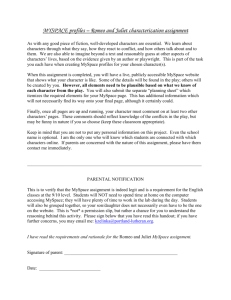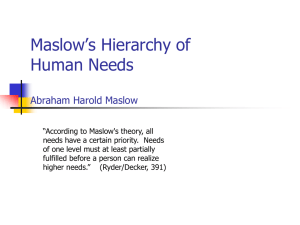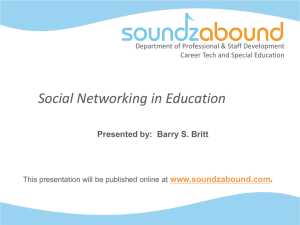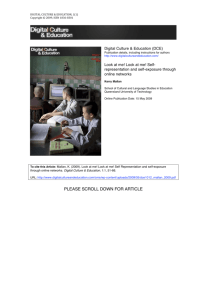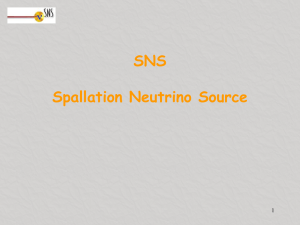Communication based-model: Uses & Gratification Model
advertisement
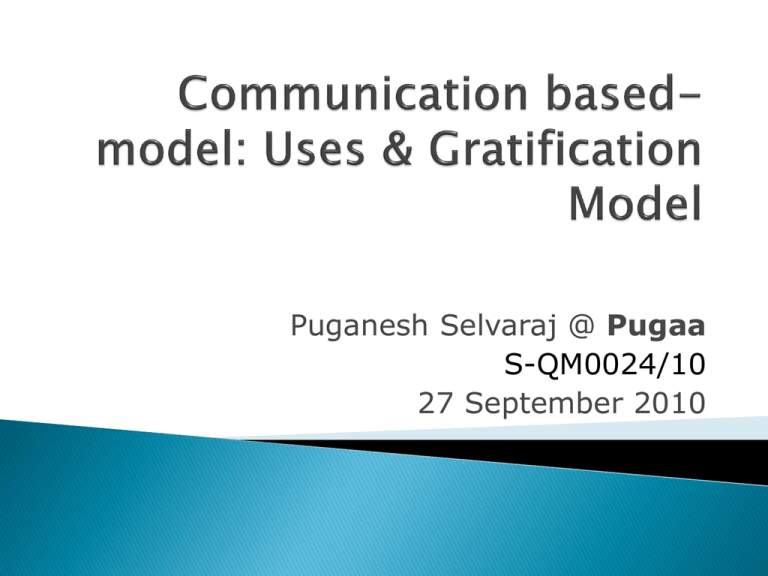
Puganesh Selvaraj @ Pugaa S-QM0024/10 27 September 2010 Introduction & Maslow’s Hierarchy of Needs Historical Development of U&G Latest: Facebook and MySpace are youths favorite! Introduction & Maslow’s Hierarchy of Needs U & G arose originally in the 1940s and underwent a revival in the 1970s and 1980s Propounded by Kartz, E. in 1970 – how people use media for gratification of their needs. Abraham Maslow create Maslow’s Hierarchy of Needs – propound that people choose what they want to see and read and different media compete to satisfy each individuals needs. There are 5 levels in the form of pyramid with the basic needs such as food and clothing at the base line and the higher order at top of pyramid. The fulfillment of each level needs leads to the individual looking to satisfy the next level of needs and so on till he reaches the superiormost need of self-actualization. Physiological Needs — water, breath, food, cloth and etc Safety Needs —security of employment, property, health, resources and etc Social Needs — family, friendship and love Esteem Needs — self esteem, achievement and self-respects Self Actualization — This level of need pertains to what a person's full potential is and realizing that potential. U & G : Type of Gratification Information – we want to satisfy our curiosity; Personal Identity – people look for models to benchmark their behaviors; Integration & Social Interaction – use the media to find out the circumstances of other people; and Entertainment – relaxation. Historical Development of U&G Beginning in the 1940s, researchers began seeing patterns under the perspective of the uses and gratifications theory in radio listeners. In 1948, Lasswell introduced a four-functional interpretation of the media on a macrosociological level Media served the functions of surveillance, correlation, entertainment and cultural transmission for both society and individuals. In 1972, Blumler and Katz extended Lasswell's four group 25 years later. These included four primary factors for which one may use the media: Diversion—Escape from routine and problems; an emotional release. Personal Relationships —Social utility of information in conversation; substitution of media for companionship. Personal Identity or Individual Psychology —Value reinforcement or reassurance; self-understanding, reality exploration. Surveillance—Information about factors which might affect one or will help one do or accomplish something Katz, Gurevitch and Haas (1973) saw the mass media as a means by which individuals connect or disconnect themselves with others Cognitive needs —Acquiring information, knowledge and understanding. Affective needs —Emotion, pleasure, feelings. Personal integrative needs —Credibility, stability, status. Social integrative needs —Family and friends. Tension release needs —Escape and diversion Individuals use Social Networking Services (SNS) to satisfy specific gratification that they seek. Famous SNS: Facebook and MySpace. Created by current CEO of eUniverse Tom Anderson’s in August 2003. At first used by the employees who participated in a contest of who can recruit more friends online. The growth is was generated from mouth-tomouth. By 2004 more teenagers join the ultimately made what is MySpace today. club and 2004: Created for Harvard students and later opened for other higher learning institutes. 2005: FB opened access to high school students. 2006: Opened the site to general public. 2007: Was reported to have more than 21 million registered members, generating 1.6 billion page views a day. Why youths use Facebook and Myspace through Uses and Gratification Theory. 1. Efficient Communication Spread news quickly to multiple users at a time Helps to get latest updates of acquaintance (ie, marriage) An efficient way for an individual to get quick response of when she or he desires attention. 2. Convenient Communication Staying in touch of family and friends and managing communication Good for long term communication Can get connected with others at a very lost cost. Enjoys receiving end of communication without having to engage in turn in any dialogue. 3. Curiosity about others Acquire information of others whom they are interested. Obtain updates about an old acquaintance Find out about new people. 4. Popularity Attempts to add as many as friends possible to increase popularity People likes getting comments from others to build up image. 5. Relationship Formation & Reinforcement Extremely useful in maintaining new pre- existing relationship and meet new people To initiate conversation between friends. Because of nature of individual’s curiosity and the desire to build and develop relationship. SNS users enjoys convenience, efficiency and popularity of using the powerful medium to convey messages and find answers. Based on the 5 elements discussed on the earlier sessions, youths use SNS to satisfy specific gratification that they seek. Blumler and Katz. 1972. The Uses of Mass Communication: Current Perspectives on Gratification Research. Katz, E., Haas, H., & Gurevitch, M. (1973). On the use of the mass media for important things. American Sociological Review, 38(2), 164-181. Mark, A. U., Qingwen, D., and Kenneth, D. 2010. Explaining why youth use MySpace and Facebook through Uses and Gratification Theory. 12(2) 215-229.

